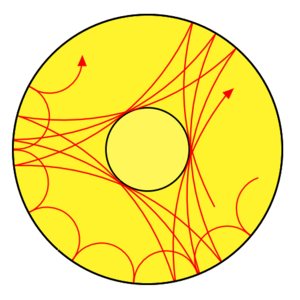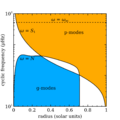Asteroseismology facts for kids
Asteroseismology is the study of how stars vibrate. Think of stars like giant musical instruments. Just as different notes from an instrument tell you about its shape and material, the vibrations (or oscillations) of a star tell scientists about its inside. This helps astronomers understand what stars are made of and how they work, even though we can't see directly inside them.
Asteroseismology is similar to helioseismology, which is the study of vibrations in our own Sun. We can learn even more about the Sun because we can see its surface in detail.
Contents
How Stars Vibrate
Stars vibrate because of different forces inside them. These vibrations create waves that travel through the star. Scientists study these waves to learn about the star's hidden parts.
There are two main types of waves:
- P-modes (Pressure modes): These are like sound waves. They are caused by changes in pressure inside the star. P-modes travel faster in hotter, denser parts of the star. They are usually found in the outer layers.
- G-modes (Gravity modes): These are caused by gravity and buoyancy (the tendency to float). They are slower waves and are usually found deeper inside the star.
By studying these different waves, astronomers can figure out what's happening in different parts of a star, from its core to its surface.
What Makes Stars Vibrate?
Stars don't just vibrate on their own. Something has to make them move! Here are some ways stars get their vibrations:
Kappa-Mechanism
Some stars have a special layer where heat gets trapped. Imagine a valve that opens and closes. When this layer contracts, it becomes more opaque, trapping more heat. This makes it expand, which then cools it down, and the cycle repeats. This "trapping" of heat causes the star to pulsate.
This mechanism drives the vibrations in many well-known variable stars, like Cepheid and RR Lyrae stars. These stars have very strong, regular vibrations.
Surface Convection
Many stars, including our Sun, have bubbling, turbulent gas near their surface. This is called convection. These bubbling motions constantly create and dampen vibrations. These vibrations are usually small and don't last very long. This is how "solar-like" stars vibrate.
Convective Blocking
Sometimes, if the bottom of a star's outer bubbling layer is very sharp, the gas flows can't react quickly enough to changes. This can cause large, strong vibrations to build up. This is thought to cause vibrations in stars like the Gamma Doradus variables.
Tidal Excitation
In some star systems, two stars orbit each other very closely. When they get closest, their gravity pulls on each other, causing vibrations. These are called "heartbeat" stars because their light changes in a way that looks like a heartbeat on a graph.
Types of Vibrating Stars
Many different types of stars vibrate. Each type tells us something unique about stars.
Solar-Like Oscillators
These stars vibrate because of the bubbling gas near their surface, just like our Sun. They include stars similar to the Sun, but also older, larger stars called subgiants and red giants.
Cepheid Variables
Cepheid variable stars are very important for measuring distances in space. They are massive stars that burn helium in their core. They vibrate with regular periods, from days to months. The faster they vibrate, the brighter they are. By measuring their vibration period, astronomers can figure out how far away they are.
RR Lyrae Variables
RR Lyrae variable stars are similar to Cepheids but are older and less massive. They also vibrate due to the kappa-mechanism. Many of them show changes in their vibration strength over long periods, known as the Blazhko effect.
Delta Scuti and Gamma Doradus Stars
Delta Scuti variable stars are usually A- or F-type stars. They vibrate quickly, with periods from 0.25 to 8 hours. Their vibrations are also caused by the kappa-mechanism.
Gamma Doradus variable stars are similar but vibrate much slower, with periods from 0.5 to 3 days. Their vibrations are thought to be caused by convective blocking. Many stars show both Delta Scuti and Gamma Doradus vibrations.
Rapidly Oscillating Ap (roAp) Stars
These stars are special because they have strong magnetic fields and unusual chemical makeups. Their vibrations are affected by their magnetic fields, which are not always lined up with how the star spins.
Slowly-Pulsating B Stars and Beta Cephei Variables
Slowly-pulsating B (SPB) stars are B-type stars that vibrate over a few days. Beta Cephei stars are hotter and more massive, vibrating over several hours. Both types of stars vibrate due to the kappa-mechanism.
Variable Subdwarf B Stars
Subdwarf B (sdB) stars are like the leftover cores of giant stars that have lost most of their outer layers. They vibrate very quickly, with periods from about 1 to 10 minutes. Their vibrations are caused by the kappa-mechanism acting on iron inside them.
White Dwarfs
White dwarfs are the dense, leftover cores of stars that have run out of fuel. Even these small, dense stars can vibrate! They vibrate in different ways depending on their type. Some are called GW Virginis stars, V777 Herculis stars, or ZZ Ceti stars. Their vibrations can range from about 1 minute to 30 minutes.
Space Missions
Satellites in space are very important for studying star vibrations because they can observe stars for long periods without interruption from Earth's atmosphere. Here are some missions that have helped us learn about asteroseismology:
- WIRE – A NASA satellite launched in 1999. Even though its main telescope failed, its smaller star tracker was used for over ten years to study bright vibrating stars.
- MOST – A Canadian satellite launched in 2003. This was the first spacecraft made just for asteroseismology.
- CoRoT – A French-led ESA satellite launched in 2006. It looked for planets and studied star vibrations.
- Kepler – A NASA spacecraft launched in 2009. It was famous for finding planets, but it also collected amazing data on star vibrations. After a problem, it was repurposed as K2 to continue its work.
- BRITE – A group of small satellites launched starting in 2013. They study the brightest vibrating stars.
- TESS – A NASA planet-finder launched in 2018. It surveys bright stars across most of the sky, providing lots of data for asteroseismology.
- PLATO – A future ESA mission planned to use asteroseismology to get very accurate sizes and masses of planets that pass in front of their stars.
Images for kids
See also
 In Spanish: Astrosismología para niños
In Spanish: Astrosismología para niños



